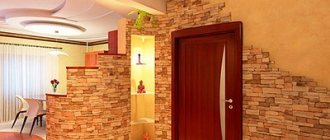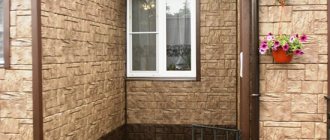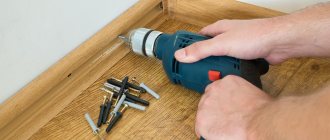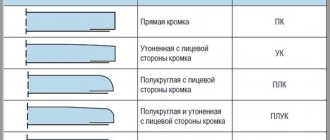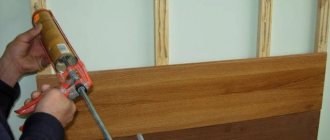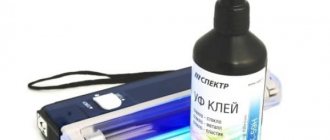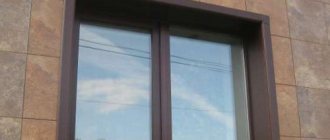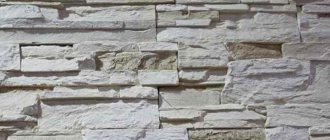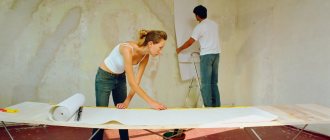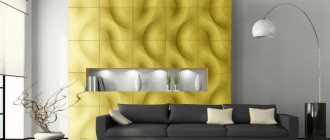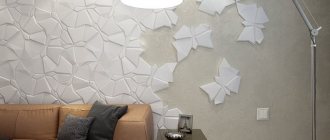PVC panels are very popular today. This can be explained quite simply: a variety of colors and sizes, panels can be made to look like decorative stone, mosaic, wood, etc.; availability by price factor; minimum preparatory work; possibility of self-installation; durability of operational properties and wide scope of application. For PVC panels, high air humidity is not at all important; they behave well in bathrooms and kitchens, because they are made on the basis of polyvinyl chloride, which reacts well to changes in temperature and moisture. Moreover, these can be either ceiling panels or wall panels. Several installation options add a number of positive points in their favor. In the case of budget repairs, this is the best solution, which can not only save money, but also carry out repair work at an accelerated pace. There is a lot of choice of ceiling and wall panels on the construction market, so everyone will choose what they need, based on all their personal criteria.
PVC wall panels
PVC panels, as a rule, have a thickness from 6 to 10 mm, a width from 9.5 to 35 cm, a length from 2.1 to 6 m. But sheet panels are also available for sale in sizes from one square to several. This is also a positive aspect of this material, since the correctly selected panel size can significantly speed up the installation process, as well as reduce the amount of unnecessary waste.
Possible installation methods
- The panels are attached with self-tapping screws or nails to a specially prepared structure made of wood or metal. The method is suitable for installation on flat walls; it is possible to hide all the wiring behind the frame. The design is easily dismantled, conceals little space, from 3 cm on each side of the room. But when covering small areas, this can be a disadvantage.
- The panels can be mounted on the prepared frame using construction clamps, staples or adhesives.
- Fixing to the wall with glue or liquid nails. The surface must be flat, otherwise after covering all defects will be visible even when using corners. This option is suitable for small rooms, since direct gluing does not reduce the space. Before gluing, there had to be a high-quality finishing of the wall surface with putty. Sheets larger than several square meters. It is recommended to mount it only this way.
- If it is necessary to hide the pipeline in the wall, it is covered with lathing, and the rest of the surface is covered without installing additional structures. A combination of two methods is used.
What kind of glue should it be?
Installation of wall panels can only be done using special mixtures designed to work with PVC parts.
Adhesives must be resistant to moisture and withstand temperature changes, especially when materials are installed in the kitchen, bathroom or shower.
We need a safe and environmentally friendly glue; there should be no pungent or alcoholic smell left after its use. If it is, the material is of poor quality. The composition should have a viscous consistency so that it does not spread after application to the wall, sets quickly and remains in place for a long time.
Universal glue cannot have such characteristics. With the correct choice of installation product and technology, the service life of the finish is extended.
How to glue PVC panels to the wall: preparatory work
How to attach MDF panels to the wall
Not everyone knows how to properly glue PVC panels, because high-quality fixation of panels depends to a large extent on the completion of preparatory work:
- The working surface must be cleaned of paint, wallpaper, old plaster, and the tiles must be dismantled;
- If there are signs of mold on the surface, this is especially true for bathrooms, carry out a complete sanitization of the problem area using special means. The fungus must be completely removed, otherwise after some time it will manifest itself again;
- Carefully seal the cracks, remove all irregularities, depressions and bumps. Ideally, seal everything with putty using beacons so that the wall is as smooth as possible. It would be a good idea to sand the walls with hard sandpaper at the final stage, this is especially true when putting putty “by eye”, without using a building level or beacons;
Wall putty
- After complete drying, the surface is treated with a primer composition for interior work, this process is needed to remove dust from the wall, which, in turn, will ensure more reliable further fixation of the panels, adhesion will increase several times;
- After the primer layer has dried, which is an average of 5-6 hours, you can begin gluing the panels.
Primer of walls
Brands of adhesives for PVC panels
To prevent the plastic elements on the walls from deforming soon, a suitable adhesive is needed.
Kleiberit
German glue, based on artificial resinous substances. Can be used in various temperature and humidity conditions.
- Packaged in different containers according to type and volume.
- Eco-friendly composition, does not contain toxic additives or harmful components.
- Resistant to high humidity.
- Dries quickly after application.
- Economical, requires application to only one surface.
- Has a homogeneous consistency.
Emphicol
Produced in Russia. You can glue panels made of plastic and other polymers. Completely transparent, after hardening it securely fixes the plastic on any rough surface.
- Can be used on any basis.
- Fixes different types of plastic mosaics.
- Moisture-resistant, withstands sudden temperature changes and exposure to condensation.
- After application it hardens quickly.
- Has increased mechanical strength.
Moment Crystal
Tightly glues slabs to any surface. Without color, it is widely used when installing suspended ceilings, plastic, and any polyvinyl chloride bases.
Panel selection
The most vulnerable point of a PVC panel is the top wall; the plate has a layered structure like cellular polycarbonate, and the thickness of the top wall is often only half a millimeter.
Such slabs are suitable for finishing the ceiling, but to finish the wall, look for something more serious, otherwise it will be easy to leave a dent on the wall, even just leaning against it.
The width of the slab is usually 25-40 cm, length - 2-3 m.
We do not recommend buying plates that are too wide, especially at small markets, as they could become warped due to improper storage.
Wide range of PVC panels
How to check a pack?
Take out a few pieces, and apply tenon to tenon and groove to groove, if there is an unevenness, you will find it. Also try joining the panels, pressing a little with your fingers to assess the strength of the outer wall, scratching with your fingernail to assess the strength of the coating. The more stiffening ribs, the stronger the plate, and they must be positioned strictly parallel and even.
Carefully inspect each plate; there should be no waves, drops, or other mechanical defects; the plate should have neatly sealed, smooth edges. If everything suits you, we buy it.
Before purchasing, calculate how many panels you will need; it is better to take 1-2 in reserve.
Comparison of sections of PVC panels: On the left are more durable due to the larger wall thickness
Liquid Nails
- Titan Wild. The brand is used not only for panels, but also for heavier finishing materials (cement sheets, plaster parts, metal). Fix ceiling plinths in any quantity. After hardening, it withstands external influences and mechanical loads.
- Quality. They are resistant to frost, so they can be used and operated all year round. After hardening, mechanical resistance appears. You can stick sheets of any shape, weight or size, both on the wall and on the ceiling.
- 601. Materials of various textures are glued, including PVC panels. The hardening time is 10 minutes, which is enough to correct the position of the slab if errors were made during installation. It has low resistance to moisture and is not recommended for use in bathrooms.
- 901. The mixture is suitable for indoor and outdoor use. The adhesive is universal, creates a strong adhesive seam, and holds even very heavy structures.
- 915. Moisture-resistant composition, usually used to secure PVC sheets in bathrooms and other rooms with high dampness.
PVC mosaic
Mosaic masonry always looks impressive, but natural materials are quite expensive. You can also make a mosaic from PVC panels, and this is done easier than it seems at first glance. Installation is carried out both in the kitchen and in the bathroom. This is a worthy replacement for ceramics; PVC is also not afraid of moisture, is resistant to temperature changes and looks decent. Another important plus: mosaic decorates small irregularities and defects in the wall due to its plasticity.
How to glue plastic mosaic tiles to the wall:
- The panels can be installed directly on the wall.
- The surface must be clean.
- The sheets are cut with a construction knife.
- Each sheet is covered with glue.
- The part is pressed tightly against the wall until it fully adheres.
- Complete drying time is 2-3 days.
- When installing mosaic parts, joints will appear. They are treated with sealant.
Installation of PVC panels is a good solution for quick DIY renovation of premises. It is not enough to choose high-quality material; accompanying products can have a greater impact on the result. So, the stronger the glue, the longer the plastic panels will last.
Correct sticking
After selecting the adhesive, installation begins. The technology includes preparation of the base, panels and their installation.
Surface preparation
If the finish will be attached to the wall, its evenness is assessed. For minor defects, the surface is leveled or puttied.
In case of strong unevenness, a sheathing is erected.
Preparing panels
Before starting work, the panels must remain in the room for 6-12 hours. Afterwards, the material is cut into pieces of the required size. The inner side is degreased to improve adhesion characteristics. Alcohol-containing mixtures can be used. Degreased surfaces hold sheets better.
Bonding technology
- If the panels are attached directly to a leveled surface, the glue is applied to their underside in dots, and after being applied to the wall, gently but firmly pressed until the finish no longer lags behind the base.
- It is enough to apply liquid nails to the back of the sheet, apply it to the wall and immediately release it. After 3-4 minutes. they will begin to harden without additional fixation.
- When fastening is done to the sheathing, PVC material is coated only in places where it will come into contact with the structure. For reliability, you can additionally use staples or screws.
After gluing, the remaining adhesive is removed from the front side of the panels. The remaining uneven joints and gaps are easily hidden under decorative plastic strips.
Common installation mistakes
- Wrong glue. After a few months or weeks of weeks, sheets may fall off the ceiling or peel off the walls. You will have to start the installation again. Choose compositions special for PVC rather than universal ones.
- Using non-moisture resistant glue in damp areas. The panels will fall off the walls within a few days after installation.
- Strong bending of plastic sheets. The material will look ugly after fixing. Frequent bends lead to rapid breakdown during operation.
- Incorrect tools for cutting PVC. You should only use a hacksaw with a tooth pitch of no more than 0.1 cm. Other tools may leave nicks on the panel.
- Using organic solvents to remove excess adhesive, stains, dirt or dyes. Such solvents leave very noticeable marks on PVC.

